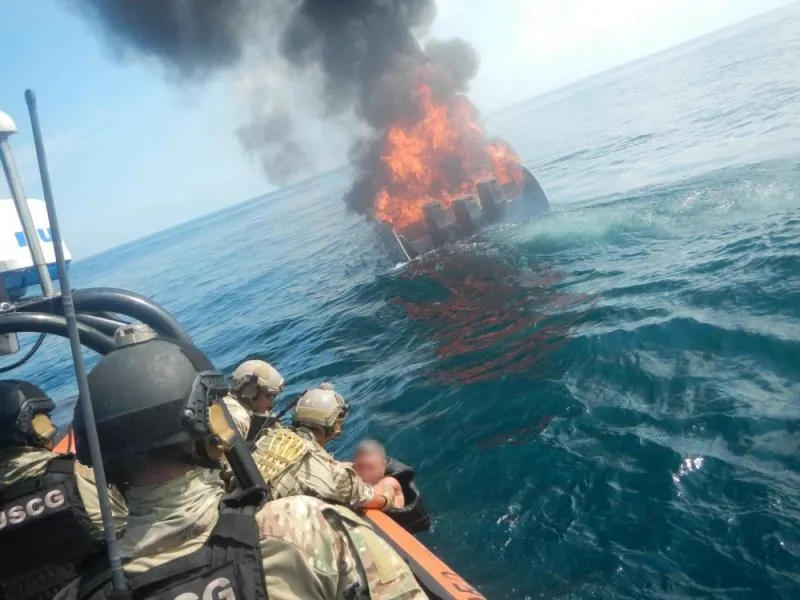ALAMEDA, Calif. — Crews from the U.S. Coast Guard, Customs and Border Protection Air and Marine Operations (AMO), the U.S. Navy’s coastal patrol ship USS Zephyr (PC 8) and the Colombian navy ship ARC “07 de Agosto” intercepted a low-profile go-fast vessel and seized more than 1,000 pounds of cocaine in the Eastern Pacific Ocean, April 7.

traveling at a high rate of speed in the
Eastern Pacific Ocean. Its four-person
crew was rescued, then arrested on
suspicion of cocaine smuggling.
During a routine counter-narcotics patrol, an AMO P-3 aircraft detected an low profile go-fast vessel, which is a custom made ocean-going, high-speed motor boat built by drug traffickers to smuggle large quantities of illegal drugs. The boats are primarily made of fiberglass and they travel barely above the surface making them difficult to see or detect by radar.
The AMO P-3 crew reported the vessel to the Joint Interagency Task Force-South, which vectored the Zephyr to make the interdiction.
As the Zephyr changed its course to intercept the vessel, the suspected smugglers allegedly began jettisoning their cargo and jumped into the water as their boat caught on fire.
A Coast Guard law-enforcement team in an interceptor boat launched from the Zephyr interdicted the vessel, rescued four suspected smugglers and transferred them to the Zephyr. The Coast Guard and Zephyr crews extinguished the fire aboard the vessel after fighting it for approximately 90 minutes.
“This interdiction serves as an example of how interagency collaboration can lead to the successful disruption of transnational criminal organizations,” said William Durham, the director of AMO's National Air Security Operations Center-Corpus Christi. “Continuing to keep our country safe from these criminal networks requires unity of effort during all phases of interdiction."
After the fire was extinguished, a Coast Guard law-enforcement team with members from both Maritime Safety and Security Team 91112 based in New Orleans, and the Pacific Tactical Law Enforcement Team based in San Diego, recovered approximately 1,080 pounds of suspected cocaine from the LPGFV. During the recovery, the “07 de Agosto” arrived on scene to work with the Coast Guard law enforcement team to document the case. This case marks the first drug interdiction for MSST New Orleans after becoming a pursuit-designated unit in July 2017.

rescued after their vessel was destroyed.
The crew are suspected of smuggling a
half ton of cocaine.
“This was an incredible team effort, between our MSST, the law enforcement detachment and USS Zephyr crews to save four lives, put out the fire and recover half a ton of cocaine,” said Lt. Cmdr. Mike McGrail, the commanding officer of MSST 91112. “This case truly highlights the danger and unpredictability our crews face every day interdicting narcotics smugglers on the open ocean.”
The vessel was severely damaged by the fire and was subsequently sunk as a hazard to navigation.
“There was no doubt in our minds what needed to be done to salvage the evidence needed for a successful prosecution even if it meant laying Zephyr alongside a burning hull, with the intense heat and acrid smoke hindering our 90-minute firefight,” said Lt. Cmdr. Grant Greenwell, the commanding officer of the Zephyr.
Air and Marine Operation’s day-to-day operations involve patrolling the seas and skies, intercepting contraband, catching smugglers and assisting in rescue and recovery operations. In Fiscal Year 2017, CBP’s Air and Marine Operations enforcement actions resulted in the approximate seizure or disruption of 269,790 pounds of cocaine; 384,230 pounds of marijuana; 5,721 pounds of methamphetamine; 1,089 weapons and $26.1 million; 2,573 arrests and 37,009 apprehensions of illegal aliens.
In addition to AMO, numerous U.S. agencies from the Departments of Homeland Security, Defense and Justice along with allied and international partner agencies, such as the Colombian navy, are involved in the effort to combat transnational criminal organizations. Counter-drug operations in the Eastern Pacific require unity of effort in all phases from detection, monitoring and interdictions, to prosecutions by the Department of Justice and partner nations.

